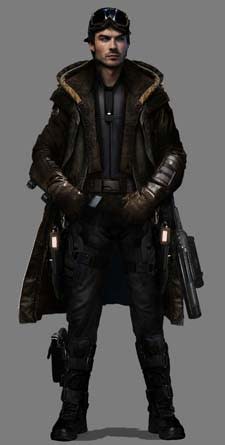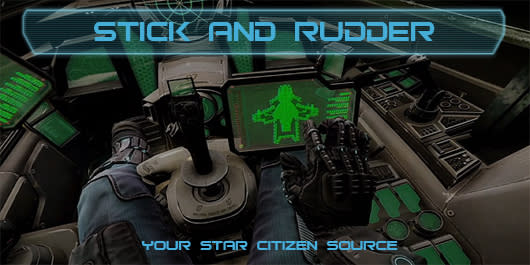Stick and Rudder: The best bits of Star Citizen's Thanksgiving livestream
Cloud Imperium hosted another lengthy Star Citizen livestream this week, and if you missed it, well, so did nearly everyone else who has a nine-to-five job. This particular shindig was some 20 hours shorter than the last one, but there were nonetheless plenty of interesting details to digest.
If you want a blow-by-blow summary -- and you don't share my aversion to Reddit -- here you go. If you want my personal highlights, click past the cut.


This time around, ClG's Santa Monica office served as mission control. Chris Roberts and a gaggle of developers and support staff spent the first few minutes on some low-key introductions before fielding questions from the 16,000-plus people following along in Twitch chat.
Community manager Ben Lesnick was piped in from CIG's Austin office for this segment, and there were quite a few interesting tidbits here. Roberts noted -- tongue-in-cheek, of course -- that the Santa Monica office features both a PlayStation 4 and an Xbox One. Not because of any looming console port, naturally, but mainly for devs to stay abreast of what's going on in the wider gaming world.
"We have an XBox One and a PS4 here, basically so we can see what everyone's doing and then say OK, we're going to destroy that, and destroy that, and destroy that, so it's for research reasons," he explained. He also the mentioned Xbox One launch title Ryse as a great example of current-gen visual fidelity that SC will surpass.

Several of the subsequent audience questions focused on instancing, and Roberts mentioned that SC's setup will make it basically impossible for a group of players to completely take over an instance. Even though the persistent universe will feature a bunch of 100-player instances, each one will feature slots reserved for capital ships and the like.
Roberts said that cap ships won't be present in the first iteration of the dogfighting module, which will likely focus on the Anvil Hornet and possibly a couple of other single-seat fighters.
As for the dogfighting module itself, it's now very likely that we're looking at a delay past the original end-of-2013 release date. Roberts said that most of the team is crunching hard on it, but there is a looming technical problem that can either be solved with a temporary fix or done "the right way."
Roberts explained that the right way will take a bit more time, and the long and short of it is that CIG "may decide to push it beyond the end of this year," so "don't shoot [him] for that."
One of my favorite questions involved customizable ship hardpoints; Roberts' answer was a gratifying one given that SC's "data-driven system" allows for hardpoints to be defined in multiple ways and for multiple equipment types. This means that you could potentially see a single hardpoint that can support either missiles or guns.
The Santa Monica dev team then talked briefly about the game's NPCs and AI, which will feature different "profiles" and thus boast radically different types of behavior (timid, aggressive, etc.) even from identical ship types. Roberts explained that the hiring of NPC wingmen will be gated by performance issues and that the number of hireable wingmen hasn't been decided yet. It's safe to assume you won't be building an army, though. "We're not an RTS game," Roberts said, before mentioning that 10 NPC wingmen or less is probable.
CIG is currently doing some R&D on cosmetic ship customization; specifically, it is investigating texturing techniques like those used in Brink and Rage. The goal is to synthesize textures at runtime so they can be "baked down" into a ship's details. This functionality isn't native to the underlying CryEngine, so it has to be custom-built. Roberts used this as an example of what is being done with the extra crowdfunding dollars. Similar tech research and upgrades may not come online tomorrow, he said, but not many games do this sort of thing, and therefore it will be worth it in the long run since the game will be running for "many many years."
Roberts then provided a bit of insight into CIG's structure. Right now the firm has dev groups working on every single part of the game, whether it be the FPS elements, planetside stuff, the hangar, the MMO backend, Squadron 42, the dogfighting module, or other assets. Before all the additional money rolled in, CIG had to work on one of these areas at a time and then move to the next. Roberts says that one of the biggest challenges in the whole project now is simply setting up the infrastructure. Ultimately, though, said infrastructure plus the additional funding will lead to a huge amount of content delivery.
"We were already competing with triple-A projects because we're lean and have no corporate overhead," Roberts explained, "but now we have the same funding the triple-As have, too."
There was a little blurb on avatar facial details, which will show up even in the dogfighting module in the form of situational reactions. Roberts also described a webcam-actuated system that immediately reminded me of SOEmote. There are also plans for the chat system to function both in-game and out-of-game via the website, mobile devices, etc.
The livestream's first hour concluded with some bits about individual data-driven ship systems that must be managed and may be individually damaged, which should lead to increased immersion. Roberts also talked about how this generates a ton of server load and cited it as one of the reasons for the possible dogfighting module delay. There was also a brief mention of Oculus Rift functionality, including relational effects and jostling perspectives based on what's happening outside your cockpit.

The livestream's second hour kicked off with the Foundry 42 video we saw last week. I've embedded it above in case you missed it. Roberts then began fielding Squadron 42-specific questions. He and lead writer Dave Haddock explained everything from story influences (Generation Kill, Apocalypse Now, World War II) to the conversation system.
The fully voiced dialogue won't feature a Mass Effect-style wheel, Roberts said, but rather a more immersive interaction system that relies on demeanor and catching someone's eye. He also said it will be similar to Wing Commander III and IV, where you can hear your own thoughts and then drive the conversation accordingly. The dialogue options won't reset, though, and Roberts was clear on the fact that he doesn't want players to just go down a conversation checklist. If you say something insensitive, for example, the conversation may end.
"It should be like real life. If you call someone a REDACTED to their face, it'll take a bit of work to come back from that," he explained.
Roberts and Haddock also talked about reputation and NPC friendships from Squadron 42 carrying over into the SC persistent world, but since real-world Air Force pilots don't get to keep their F-16s when they leave the service, Squadron 42 pilots won't be carrying their ships forward to Star Citizen. There has been no decision on difficulty levels yet, and the Squadron 42 co-op functionality will be a drop-in-drop-out mechanic where your friends can take over for one of your wingmen.
Haddock likened this to the Matrix films, where the agents jump in and out of various bodies inside the Matrix proper. Roberts mentioned that there is ground-based combat and boarding/FPS stuff in Squadron 42. He also cleared up any misconceptions about Squadron 42 being a tutorial for Star Citizen. While the single-player game will introduce players to SC systems, it is basically a current-gen Wing Commander-type title. "It absolutely could be a standalone triple-A game," he said.

Roberts then brought in Star Citizen audio director Martin Galway and composer Pedro Camacho to field questions. Discussion included in-game radio broadcasts, both player-driven and AI/fiction-based, as well as jukebox systems and Camacho's methods for composing music.
"I personally believe that there is no instrument better than the human voice, but it's also very difficult to do well," he said in answer to a query as to whether or not the orchestral soundscape will feature choral parts.
At this point, and in keeping with CIG livestreaming traditions, fans preceded to crash Camacho's personal website as they sought to soak up information about both Star Citizen and his previous work.
The next hour saw the livestream switch to CIG's Austin office. The dev team there talked up various lighting, programming, and UI-related shenanigans, and viewers were treated to the mind-blowing Avenger reskin video that I've embedded below.

Producer Eric Peterson said that we can expect two hangar patches prior to Christmas, and PR director Sandi Gardener updated fans on next year's convention circuit plans that include PAX Australia, PAX East, DragonCon, Gamescom, and potentially a huge CitizenCon depending on facility availability.

Next up was the HUD workflow video, which featured programmer Brandon Evans, designer Zane Bien, and film veteran John Likens talking about the design and integration process. Most interesting from my perspective was the fact that CIG has coded in such a way as to have "real" ship systems that will allow for targeting of individual components and system failures akin to those of real aircraft. Roberts did chime in here to say that random system failures aren't currently planned, though.

The stream wrapped up with a nifty look at some new weapon test firing functionality that's coming soon to your hangar module. The devs lined up target dummies and preceded to mow them down with a couple of different floor-mounted gun types. They also demoed functionality that will allow players to switch gun types via the loadout terminal currently residing in your hangar module.
This functionality appears to be CIG's stand-in for the likely dogfighting module delay, as Roberts said we can expect to see it in the next few weeks alongside possible thruster firing tests. Roberts wrapped up the show's final hour with a thank-you to all of Star Citizen's backers. He that the project has almost transcended being a video game and is instead morphing into a "destination where people want to spend a lot of time."


Whether it's interviews with Chris Roberts and the Cloud Imperium team or tips and guides for pushing your ship's performance envelope, Stick and Rudder is your inside source for news and commentary on the world of Star Citizen. Join Jef Reahard every other week during the run-up to alpha, beta, and beyond.



